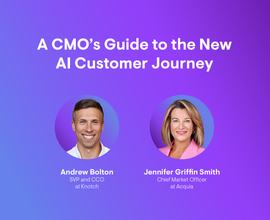Marketing During a Recession: 6 Strategies to Maximize Your Marketing Budget
Seeing budgets tighten during the current economic downturn? These strategies will help you maximize your marketing efforts while minimizing your budget.
We are entering another period of economic uncertainty. Inflation has hit a decades-long high, tech stocks are tumbling , supply chains remain snarled , and workers have not returned to the office in the same numbers since the start of the pandemic.
Businesses are scrambling to prepare for this volatility. In general, leaders like to hold onto cash as a buffer during recessionary times. This often entails limiting spend on a variety of non-core activities or putting a freeze on hiring.
Budget cuts happen. But by being strategic about where you spend your marketing dollars, you can maximize the spend you do have to generate the highest returns and position your business for a strong rebound. Smart leaders use moments of uncertainty to invest thoughtfully in the future, not just short-term survival. Forward-thinking strategies focused on your highest-performing channels will help you thrive during both booms and busts. In this guide, we highlight the top marketing strategies during a recession and how to implement them.
Why SEO is the best marketing strategy during a recession
Recessions often end with the economy roaring back stronger than it was before. SEO and content marketingContent Marketing
Content marketing is a marketing discipline with the goal of increasing awareness and scope for products and brands in the desired target group with content published on the web and offline.
Learn more are the best places to invest limited resources during leaner times since they pay both short- and long-term dividends. You can leapfrog ahead of the competitionCompetition
Businesses generally know who their competitors are on the open market. But are they the same companies you need to fight to get the best placement for your website? Not necessarily!
Learn more by focusing on building your organic presence when competitors are likely making budget cuts or investing their limited spend in channels with diminishing returns.
Play the long game with SEO
SEO experts play the long game. If most paid media spend is like investing in stock (expensive with the potential for quick wins), then SEO/content spend is like investing in bonds—high-yield and low-risk. You invest today and continue to drive consistent value for years to come. So in an economic downturn when your paid media budgets may be limited, SEO is the best strategy to dedicate your time and efforts to.
Kroger, the largest U.S. grocery chain, knows this firsthand. Having recently expanded into the highly competitive eCommerce space, the team at Kroger struggled to get websites to rank for non-branded search terms. Of course, Kroger could have simply continued to plow money into pricey PPC ads to enhance its visibility. But this strategy is expensive, burning through cash quickly and failing to build a foundation for growth. Kroger could have become dependent on paid spend, leaving its marketing and revenue teams at the mercy of Google’s pricing.
Instead, Kroger partnered with Conductor to invest in creating an SEO strategy. With Conductor’s support, the team at Kroger opted to invest in developing content around new topics and categories based on demand and interest from their target audience. After a relatively small outlay for content creation and research, Kroger’s new content is building long-term visibility for the brand. Kroger’s new strategy helped increase organic traffic to their website by 7% year over year, resulting in millions of additional visitors per month.
Maximize SEO ROI
When evaluating your channel mix, return on investment (ROI) is one of the most important measures of success. SEO offers consistently high ROI compared to other channels. One recent study calculated that each dollar invested in SEO leads to a whopping $22 return .
In the past, SEO investments have felt like a black box. The ROI is not always as easily quantifiable as paid media. As marketing leaders, we all like immediate and easy-to-see results.
SEO requires an investment in content creation and optimization. It can be more difficult to measure ROI. We’ve written extensively about this in our recent in-depth guide on measuring marketing ROI. The trick is to implement a multi-touch attribution model to assess the influence of each channel. Great leaders recognize the potential ROI of SEO efforts and encourage their teams to invest.
Rather than making blanket cuts to your marketing spend during a recession, identify your top-performing channels from an ROI perspective first. That way, you can make informed adjustments to spend, improving your budget’s efficiency by shifting budget towards higher-performing investments like SEO.
SEO fuels all marketing efforts
Another reason why SEO is a great investment during a downturn is because it fuels your other marketing channels. Creating customer-first content is the foundation to successful SEO and ranking high in the search results.
Value-driven content can also power other channels by being featured in paid campaigns, social media posts, newsletters, targeted email outreach, and more.
Additionally, you can use search data to optimize your paid budget, both by pulling back on PPC spend for areas that you are already visible for organically and by increasing spend on harder-to-win keywords. You can use your SEO investment to power multiple marketing channels, increasing its effectiveness.
Meet your customers where they already are
Consumer behavior can change during a recession, from lack of spending on unnecessary luxuries to reduced travel and mobility . During recessions and booms alike, however, your customers rely on search engines to help them find the answers they need. As a result, your investments in SEO will help reach potential customers in all economic climates. Tracking Google searches can help you understand what types of questions your customers are asking and how they change during a downturn.
For example, consider a hypothetical hotel brand: they may find that people are looking for staycations or cheap travel ideas in secondary cities during a recession. In such a case, the brand may want to pivot its content marketing strategy to focus on affordable travel in lesser-known places and how customers can save by booking with their brand.
Use organic search data to help build brand and customer loyalty during tough times. By answering a need, your customers will value your brand and become more likely to prioritize or revisit your offerings once things improve.
Top strategies to grow your organic presence and business during a recession
Growth during a recession may seem unrealistic, but smart growth is still possible with the right marketing strategies. By focusing on the key areas below, you can drive the most impact and maximize your spend across all channels.
1. Embrace a customer-first marketing strategy
One of the best ways to survive times of economic uncertainty is by building trust with your target audience through customer-first marketing. As mentioned above, this is not only good for SEO but your other marketing channels as well.
What is customer-first marketing? Simply put, customer-first marketing means building your marketing organization with a single-minded focus on your customers and how you can help them. Instead of focusing on the business’s bottom line, prioritize how you can help people with your product or service through valuable marketing. Find out how to implement a customer-first strategy by downloading the full guide.
2. Identify new opportunities through your search data
Did you know your SEO team is sitting on a gold mine of customer data? From Google Search ConsoleGoogle Search Console
The Google Search Console is a free web analysis tool offered by Google.
Learn more (GSC) to web analytics, your existing data can unlock real value for your business. Learn how by downloading the full Marketing During a Recession Guide.
3. Align paid and organic teams to maximize your spend
Paid and organic synergy is one of the best cost savings strategies that comes with SEO investment. Get insights into how to improve alignment between your paid media and SEO teams to optimize your paid spend in the full guide.
4. Optimize new and existing content for SEO
Successful SEO implementation pays serious dividends. Customer-first content that ranks on the first page of Google can drastically impact brand awareness, visibility, traffic, and conversions. Download the full guide for two additional strategies on how to optimize both new and existing content to drive the highest possible ROI.
Now is the time to invest in the future
At Conductor, we always say that the best time to plant a tree was yesterday, but the second best time is today. A downturn can be an opportunity—consider it the right time to start growing roots that will help you weather current and future storms.
Download the Marketing During a Recession Guide now for exclusive in-depth insights and additional strategies to maximize your marketing budget and fuel growth.







